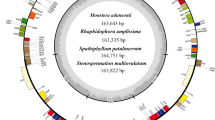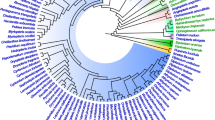Abstract
Relative rate tests, using Gnetum as a reference taxon, were conducted on nuclear 18S rRNA sequences from 10 angiosperms including autotrophic nonparasites (Arabidopsis, Asarum, Glycine, Malpighia, and Zea), a chlorophyllous hemiparasite (Arceuthobium—Viscaceae), and achlorophyllous holoparasites (Balanophora—Balanophoraceae, Prosopanche—Hydnoraceae, and Rafflesia and Rhizanthes—Rafflesiaceae). Compared with Glycine, the mean number of substitutions per site (K) for five autotrophic angiosperms is 0.036 whereas for the holoparasites K = 0.126, i.e., 3.5 times higher. Comparisons of autotrophic species with short and long generation times showed no differences in K; hence, divergent rRNA sequences in the holoparasites are likely attributable to other mechanisms. These might include genetic bottlenecks, effective population size, and/or molecular drive. High substitution rates appear to be associated only with those parasitic angiosperms that have developed a highly modified haustorial system and extreme nutritional dependence upon the host. At present, high substitution rates in these parasites confound attempts to determine their phylogenetic position relative to other angiosperms.
Similar content being viewed by others
References
Albert VA, Williams SE, Chase MW (1992) Carnivorous plants: phylogeny and structural evolution. Science 257:1491–1495
Arnheim ND Krystal M, Schmickel R, Wilson G, Ryder O, Zimmer E (1980) Molecular evidence for genetic exchanges among ribosomal genes on nonhomologous chromosomes in man and apes. Proc Natl Acad Sci USA 77:7323–7327
Bosquet J, Strauss SH, Doerksen AH, Price RA (1992) Extensive variation in evolutionary rate of rbcL gene sequences among seed plants. Proc Natl Acad Sci USA 89:7844–7848
Brown DD, Wensink PC, Jordan E (1972) A comparison of the ribosomal DNA's of Xenopus laevis and Xenopus mulleri: The evolution of tandem genes. J Mol Biol 63:57–73
Cabot EL, Beckenbach AT (1989) Simultaneous editing of multiple nucleic acid and protein sequences with ESEE. Comp Appl Biosci 5:233–234
Chase MW, Soltis DE, Olmstead RG, Morgan D, Les DH, Mishler BD, Duvall MR, Price RA, Hills HG, Qiu Y-L, Kron KA, Rettig JH, Conti E, Palmer JD, Manhart JR, Sytsma KJ, Michaels HJ, Kress WJ, Karol KG, Clark WD, Hedrén M, Gaut BS, Jansen RK, Kim K-J, Wimpee CF, Smith JF, Furnier GR, Strauss SH, Xiang QY, Plunkett GM, Soltis PS, Swensen SM, Williams SE, Gadek PA, Quinn CJ, Eguiarte LE, Golenberg E, Learn GH Jr, Graham SW, Barrett SCH, Dayanandan S, Albert VA (1993) Phylogenetics of seed plants: an analysis of nucleotide sequences from the plastid gene rbcL. Ann Mo Bot Gard 80:528–580
Crane PR (1985) Phylogenetic analysis of seed plants and the origin of angiosperms. Ann Mo Bot Gard 72:716–793
Cronquist A (1988) The evolution and classification of flowering plants, 2nd ed. The New York Botanical Garden, Bronx, NY
Cullings KW, Bruns TD (1992) Phylogenetic origin of the Monotropoideae inferred from partial 28S ribosomal RNA gene sequences. Can J Bot 70:1703–1708
Cullis CA (1984) Quantitative variation of the ribosomal RNA genes. In: Jordan EG, Cullis CA (eds) The nucleolus. Cambridge University Press, Cambridge, pp 103–112
dePamphilis CW, Palmer JD (1990) Loss of photosynthetic and chlororespiratory genes from the plastid genome of a parasitic flowering plant. Nature 348:337–339
Dover G (1982) Molecular drive: a cohesive mode of species evolution. Nature 299:111–117
Dover GA (1987) DNA turnover and the molecular clock. J Mol Evol 26:47–58
Dover G, Coen E (1981) Springcleaning ribosomal DNA: a model for multgene evolution? Nature 290:731–732
Doyle JJ, Doyle JL (1987) A rapid DNA isolation procedure for small quantities of fresh leaf tissue. Phytochem Bull 19:11–15
Eckenrode VK, Arnold J, Meagher RB (1985) Comparison of the nucleotide sequence of soybean 18S rRNA with the sequences of other small-subunit rRNAs. J Mol Evol 21:259–269
Felsenstein J (1978) Cases in which parsimony or compatibility will be positively misleading. Syst Zool 27:410–410
Fitch WM, Margoliash E (1967) Construction of phylogenetic trees. Science 155:279–284
Gaut BS, Muse SV, Clark WD, Clegg MT (1992) Relative rates of nucleotide substitution at the rbcL locus of monocotyledonous plants. J Mol Evol 35:292–303
Gedalovich-Shedletzky E, Kuijt J (1990) An ultrastructural study of the tuber stands of Balanophora (Balanophoraceae). Can J Bot 68: 1271–1279
Gutell RR (1993) Collection of small subunit (168- and 16S-like) ribosomal RNA structures. Nucleic Acids Res 21:3051–3054
Hamby KR, Zimmer EA (1992) Ribosomal RNA as a phylogenetic tool in plant systematics. In: Soltis PS, Soltis DE, Doyle JJ (eds) Molecular systematics of plants. Chapman and Hall, New York, pp 50–91
Ismail G (1988) Conservation of the giant Rafflesia in Sabah, Malaysia. TREE 3:316–317
Kimura M (1987) Molecular evolutionary clock and the neutral theory. J Mol Evol 26:24–33
Klekowski EJ (1988) Mechanisms that maintain the genetic integrity of plants. In: Greuter W, Zimmer B (eds) Proceedings of the XIV International Botanical Congress. Koeltz, Königstein/Taunus, pp 137–152
Kuijt J (1969) The biology of parasitic flowering plants. University of California Press, Berkeley, p 246
Kunkel TA, Loeb LA (1982) Fidelity of mammalian DNA polymerases. Science 213:765–767
Lake JA (1987) Determining evolutionary distances from highly diverged nucleic acid sequences: operator metrics. J Mol Evol 26: 59–73
Meijer W (1958) A contribution to the taxonomy and biology of Rafflesia arnoldi in West Sumatra. Ann Bogorienses 3:33–44
Messing J, Carlson J, Hagen G, Rubenstein I, Oleson A (1984) Cloning and sequencing of the ribosomal RNA genes in maize: the 17S region. DNA 3:31–40
Mullis KB, Faloona FA (1987) Specific synthesis of DNA in vitro via a polymerase-catalyzed chain reaction. Methods Enzymol 155: 335–350
Neefs J-M, Van de Peer Y, De Rijk P, Chapelle S, De Wachter R (1993) Compilation of small subunit RNA structures. Nucleic Acids Res 21:3025–3049
Nickrent DL, Sargent ML (1991) An overview of the secondary structure of the V4 region of eukaryotic small-subunit ribosomal RNA. Nucleic Acids Res 19:227–235
Nickrent DL, Franchina CR (1990) Phylogenetic relationships of the] Santalales and relatives. J Mol Evol 31:294–301
Nickrent DL (1994) From field to film: rapid sequencing methods for field-collected plant species. Biotechniques 16:470–475
Price PW (1980) Evolutionary biology of parasites. Monographs in Population Biology No. 15. Princeton University Press, Princeton, p 237
Saitou N, Nei M (1987) The neighbor-joining method: a new method for reconstructing phylogenetic trees. Mol Biol Evol 4:406–425
Sarich VM, Wilson AC (1967) Rates of albumin evolution in primates. Proc Natl Acad Sci USA 58:142–148
Sogin ML, Elwood HH, Gunderson HH (1986) Evolutionary diversity of eukaryotic small-subunit rRNA genes. Proc Natl Acad Sci USA 83:1383–1387
Takhtajan AL (1980) Outline of the classification of flowering plants (Magnoliophyta). Bot Rev 46:225–359
Takhtajan AL (1987) Systema Magnoliophytorum. Nauka, Leningrad (in Russian)
Thorne RF (1992) An updated classification of the flowering plants. Aliso 13:365–389
Topal MD, Fresco JR (1976) Complementary base pairing and the origin of substitution mutations. Nature 263:285–289
Unfried I, Stocker U, Gruendler P (1989) Nucleotide sequence of the 18S rRNA gene from Arabidopsis thaliana Co10. Nucleic Acids Res 17:7513
Van de Peer Y, Neefs J-M, De Rijk P, De Wachter R (1993) Reconstructing evolution from eukaryotic small-ribosomal-subunit RNA sequences: calibration of the molecular clock. J Mol Evol 37:221–232
Vawter L, Brown WM (1986) Nuclear and mitochondrial DNA comparisons reveal extreme rate variation in the molecular clock. Science 234:194–196
Wilson AC, Carlson SS, White TJ (1977) Biochemical evolution. Annu Rev Biochem 46:573–639
Woese CR (1987) Bacterial evolution. Microbiol Rev 51:221–271
Wolfe KH, Li W-H, Sharp PM (1987) Rates of nucleotide substitution vary greatly among plant mitochondrial, chloroplast, and nuclear DNAs. Proc Natl Acad Sci USA 84:9054–9058
Wolfe KH, Katz-Downie DS, Morden CW, Palmer JD (1992) Evolution of the plastid ribosomal RNA operon in a nongreen parasitic plant: accelerated evolution, altered promoter structure, and tRNA pseudogenes. Plant Mol Biol 18:1037–1048
Wolfe KH, Gouy M, Yang Y-W, Sharp PM, Li W-H (1989a) Date of the monocot-dicot divergence estimated from chloroplast DNA sequence data. Proc Natl Acad Sci USA 86:6201–6205
Wolfe KH, Sharp PM, Li W-H (1989b) Rates of synonymous substitution in plant nuclear genes. J Mol Evol 29:208–211
Wu C-I, Li W-H (1985) Evidence for higher rates of nucleotide substitution in rodents than in man. Proc Natl Acad Sci USA 82:1741–1745
Author information
Authors and Affiliations
Additional information
Correspondence to: D.L. Nickrent
Rights and permissions
About this article
Cite this article
Nickrent, D.L., Starr, E.M. High rates of nucleotide substitution in nuclear small-subunit (18S) rDNA from holoparasitic flowering plants. J Mol Evol 39, 62–70 (1994). https://doi.org/10.1007/BF00178250
Received:
Revised:
Issue Date:
DOI: https://doi.org/10.1007/BF00178250




